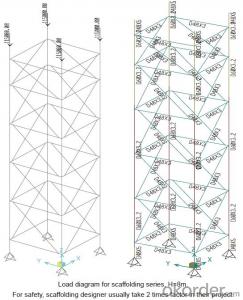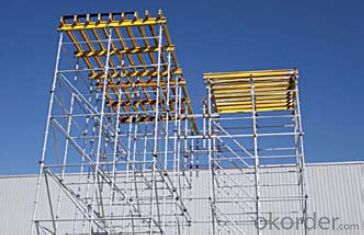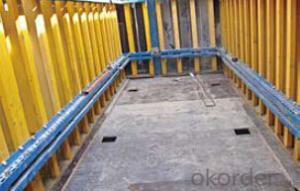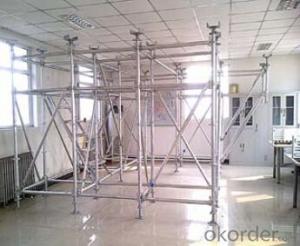Ring-Lock Scaffolding accessories for formwork and scaffolding system
- Loading Port:
- Tianjin
- Payment Terms:
- TT OR LC
- Min Order Qty:
- 50 m²
- Supply Capability:
- 1000 m²/month
OKorder Service Pledge
Quality Product, Order Online Tracking, Timely Delivery
OKorder Financial Service
Credit Rating, Credit Services, Credit Purchasing
You Might Also Like
Ring-lock Scaffolding
A support system for construction, ownsadvantages of both cup-lock scaffolding andshoring tower.
It is in the development direction of new typescaffolding.
It is widely used in buildings, bridges, tunnels etc..
Characteristics:
◆ Easy to storage and transportation
◆ High degree of standardization
◆ Easy and quick erection
◆ Excellent stability and bearing capacity
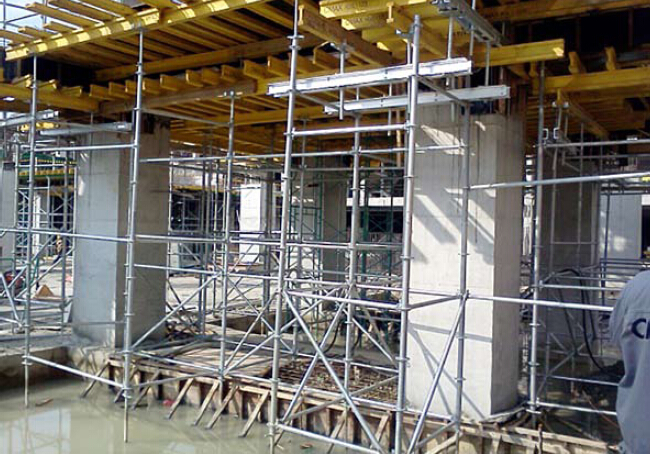
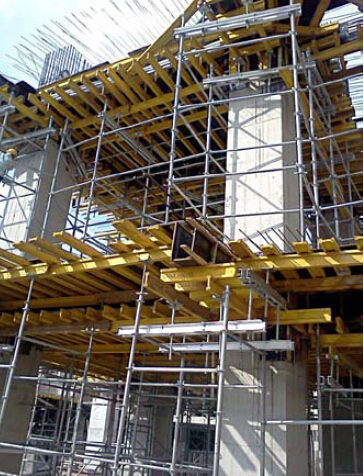
- Q: Can steel formwork be used for office building construction projects?
- Office building construction projects can indeed utilize steel formwork. This option, known for its versatility and durability in concrete construction, presents numerous advantages. With its exceptional strength and stability, steel formwork can withstand the pressures and loads encountered throughout the construction process. Furthermore, its reusability renders it a cost-effective choice for extensive undertakings such as office buildings. Moreover, the assembly and disassembly of steel formwork are effortless, facilitating swift and efficient construction and enabling faster turnaround times. Overall, steel formwork stands as a fitting choice for office building construction projects due to its robustness, longevity, cost-effectiveness, and efficiency.
- Q: What are the typical dimensions of steel formwork panels?
- The typical dimensions of steel formwork panels can vary depending on the specific requirements of the construction project. However, common dimensions for steel formwork panels range from 1.2 meters to 2.4 meters in width and 1.2 meters to 3 meters in height. These dimensions are designed to provide stability and versatility while accommodating various construction needs.
- Q: What are the different types of edge protections available for steel formwork?
- There are several types of edge protections available for steel formwork, including steel edge angles, timber edge fillets, plastic edge profiles, and rubber edge guards. These edge protections are used to ensure the safety of workers by preventing them from accidentally stepping off the edge of the formwork.
- Q: Can steel formwork be used for soundproofing walls?
- Steel formwork is mainly utilized in construction to shape and structure concrete walls. Although steel formwork is strong and long-lasting, it is not designed for soundproofing. For soundproof walls, materials with excellent acoustic performance and insulation properties are necessary to effectively block or absorb sound waves. While steel formwork may provide some sound reduction due to its density, it is not enough to achieve significant soundproofing outcomes. To effectively soundproof walls, it is advisable to use specialized materials like acoustic insulation, mass-loaded vinyl, or soundproof drywall, which are specifically designed for this purpose.
- Q: Can steel formwork be used for both vertical and horizontal structures?
- Yes, steel formwork can be used for both vertical and horizontal structures. Steel formwork is a versatile and durable construction material that can be molded and shaped to meet the requirements of various structural elements. It can be used for constructing walls, columns, beams, slabs, and other structural elements in both vertical and horizontal orientations. The strength and rigidity of steel make it suitable for withstanding the pressure exerted by concrete during the casting process, ensuring that the formwork maintains its shape and stability. Additionally, steel formwork is reusable and can be easily dismantled and reassembled, making it a cost-effective and efficient choice for construction projects involving both vertical and horizontal structures.
- Q: Can steel formwork be used for industrial structures?
- Indeed, steel formwork proves to be a viable option for constructing industrial structures. This method involves utilizing steel panels or sheets to establish temporary molds or frameworks, which then hold and shape the concrete throughout the construction process. The utilization of steel formwork is particularly favored in industrial construction due to its robustness, durability, and capacity to endure heavy loads and high pressures. The construction of industrial structures often necessitates formwork systems that can withstand the weight of substantial concrete pours and provide ample support during the curing phase. Steel formwork showcases these qualities, rendering it an ideal selection for industrial projects. Furthermore, steel formwork guarantees exceptional dimensional accuracy, ultimately ensuring precise and consistent outcomes in the construction of industrial structures. Additionally, it can be easily adjusted and reused, leading to cost savings and improved efficiency throughout the construction process. Another notable advantage of steel formwork lies in its ability to withstand adverse weather conditions and extreme temperatures, thus rendering it suitable for a diverse range of industrial settings. Its resistance to warping, cracking, and other forms of damage ultimately safeguards the structure's integrity and longevity. Moreover, steel formwork can be customized to meet the specific requirements of various industrial structures, thereby allowing for flexibility in design and construction. Its ease of assembly and disassembly facilitates faster construction cycles and reduces overall project timelines. To conclude, steel formwork emerges as an exceedingly suitable choice for industrial structures due to its strength, durability, dimensional accuracy, weather resistance, and flexibility. The numerous advantages it offers over alternative formwork materials position it as the preferred option within the construction industry.
- Q: What are the common design considerations for steel formwork in high-rise buildings?
- When it comes to designing steel formwork for high-rise buildings, there are several common considerations that need to be taken into account. These considerations are crucial for ensuring the structural integrity, safety, and efficiency of the formwork system. 1. Load capacity: Steel formwork needs to be able to withstand the loads it will be subjected to during the construction process. This includes the weight of the concrete, workers, equipment, and any other imposed loads. The formwork should be designed to have sufficient load capacity to prevent any deformation or failure. 2. Stability: High-rise buildings are subjected to various external forces such as wind and seismic loads. The formwork system needs to be stable and resistant to these forces to prevent any accidents or collapse. Proper bracing, tie-downs, and anchorage systems should be incorporated into the design to ensure stability. 3. Durability: Steel formwork must be able to withstand the harsh conditions of construction sites, including exposure to moisture, chemicals, and physical impact. The material selection and protective coatings should be chosen carefully to ensure long-term durability and prevent corrosion. 4. Flexibility: High-rise buildings often have complex geometries with different floor layouts, wall configurations, and column sizes. The formwork system should be flexible enough to accommodate these variations and allow for easy adjustments and reusability. Modular formwork systems are commonly used to provide this flexibility. 5. Safety: Safety is of utmost importance in high-rise construction. The design of the formwork system should incorporate safety features such as non-slip surfaces, guardrails, access platforms, and fall protection systems. Adequate space for workers to move around and perform their tasks safely should also be considered. 6. Construction timeline: Time is a critical factor in high-rise construction projects. The formwork system should be designed to enable fast and efficient construction, minimizing downtime and delays. This could involve using pre-fabricated components, easy assembly and disassembly methods, and efficient material handling systems. 7. Cost-effectiveness: The design of the steel formwork system should optimize cost-effectiveness without compromising on quality and safety. This includes factors such as material selection, formwork reuse, efficient use of labor, and minimizing waste. Overall, the design considerations for steel formwork in high-rise buildings revolve around load capacity, stability, durability, flexibility, safety, construction timeline, and cost-effectiveness. By carefully addressing these considerations, designers can ensure a successful and efficient construction process for high-rise buildings.
- Q: What are the different types of coatings available for steel formwork panels?
- There are several types of coatings available for steel formwork panels, each offering unique benefits and applications. 1. Galvanized Coating: This is one of the most common types of coatings used for steel formwork panels. It involves applying a layer of zinc to the surface of the steel through a process called galvanization. Galvanized coatings provide excellent corrosion resistance, making them suitable for outdoor and high-moisture environments. 2. Epoxy Coating: Epoxy coatings are known for their superior chemical and abrasion resistance. They are applied as a two-part system that combines resin and a hardener. Epoxy coatings create a strong, durable surface that can withstand heavy use and exposure to various chemicals. They are often used in industrial settings or where high performance is required. 3. Polyurethane Coating: Polyurethane coatings offer excellent resistance to abrasion, impact, and weathering. They are commonly used in applications where a high level of durability is needed, such as in construction projects or infrastructure development. Polyurethane coatings also provide good adhesion to the steel surface, ensuring long-lasting protection. 4. Powder Coating: Powder coating is a dry finishing process where a fine powder is electrostatically applied to the steel surface. It is then cured under heat to form a hard, protective layer. Powder coatings come in a wide range of colors and provide excellent resistance to chipping, scratching, and fading. They are commonly used for aesthetic purposes or in applications where a decorative finish is desired. 5. Zinc-rich Coating: Zinc-rich coatings are similar to galvanized coatings, but they contain a higher concentration of zinc particles. These coatings provide enhanced corrosion protection and are often used in highly corrosive environments, such as marine or coastal areas. Zinc-rich coatings can be applied either by spraying or brushing. 6. Fire-resistant Coating: Fire-resistant coatings are specifically designed to provide protection against the spread of fire. These coatings create a barrier that delays the heating of steel, helping to prevent the structural collapse of a building during a fire. Fire-resistant coatings are commonly used in commercial and industrial buildings, as well as in infrastructure projects. It is important to consider the specific requirements of the project and consult with experts to determine the most suitable coating for steel formwork panels. Factors such as the environment, expected durability, and budget should be taken into account to ensure optimal performance and longevity.
- Q: Can steel formwork be used in tunnel construction?
- Certainly, tunnel construction can utilize steel formwork. Steel formwork is extensively employed in various construction endeavors, such as tunnel construction, owing to its resilient nature, formidable strength, and adaptability. It furnishes a sturdy supporting structure capable of withstanding the immense pressure and strain exerted by the encompassing soil and rock during tunneling operations. The design of steel formwork facilitates effortless assembly and disassembly, thereby enabling efficient tunnel construction. It can be tailored to match the specific shape and dimensions of the tunnel, ensuring accuracy and precision in formwork. Furthermore, steel formwork can be repeatedly utilized, rendering it a cost-effective solution for tunnel construction projects.
- Q: How does steel formwork contribute to better site organization?
- Steel formwork contributes to better site organization in several ways. Firstly, steel formwork is highly durable and reusable, which means it can be used multiple times on different construction projects. This eliminates the need for frequent replacement and reduces waste on site. The ability to reuse steel formwork also reduces storage space requirements, as it can be easily stacked and stored when not in use. Secondly, steel formwork is adjustable and customizable, allowing it to be easily modified to fit different shapes and sizes of concrete structures. This flexibility enables efficient use of space on site, as the formwork can be tailored to the specific requirements of each project. This ensures that the construction process is organized and streamlined, minimizing the need for additional materials or adjustments. Furthermore, steel formwork is known for its high strength and stability, which enhances site safety. Its robust structure provides a secure platform for workers to carry out their tasks, reducing the risk of accidents or injuries. This promotes a safer working environment and improves overall site organization. Steel formwork also contributes to better site organization by facilitating faster construction cycles. Its quick assembly and disassembly process allows for efficient and smooth workflow, enabling construction projects to be completed in a timely manner. This helps to minimize delays and ensures that the site is well-organized and productive. Lastly, steel formwork can be easily integrated with other construction systems and technologies. This compatibility allows for seamless coordination between different components of the project, promoting better site organization. Whether it is integrating with scaffolding systems or connecting to other structural elements, steel formwork ensures a cohesive and well-organized construction site. In conclusion, steel formwork contributes to better site organization through its durability, adjustability, strength, and compatibility with other construction systems. Its ability to be reused, customized, and integrated with other components enhances efficiency, safety, and productivity on construction sites.
Send your message to us
Ring-Lock Scaffolding accessories for formwork and scaffolding system
- Loading Port:
- Tianjin
- Payment Terms:
- TT OR LC
- Min Order Qty:
- 50 m²
- Supply Capability:
- 1000 m²/month
OKorder Service Pledge
Quality Product, Order Online Tracking, Timely Delivery
OKorder Financial Service
Credit Rating, Credit Services, Credit Purchasing
Similar products
Hot products
Hot Searches
Related keywords

